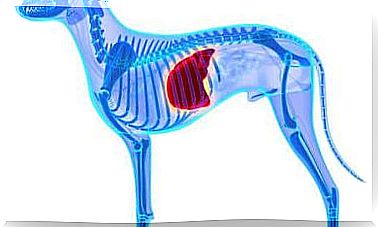Panting And Tremors In Dogs: Causes And Treatments

Shortness of breath and tremors in dogs can range from the body’s natural responses to prolonged exertion to indicators of an underlying condition. Observing the animal’s mood and the frequency of these or other symptoms can elucidate the diagnosis.
There are certain situations, such as excessive heat, strenuous exercise, old age, or being overweight, that cause these basic signs of exhaustion. Panting contributes to cooling the body, as does agitation, which is also shown in moments of excitement. However, tremors in dogs, perceived as small uncoordinated movements, can indicate an important physiological disorder.
Guardians may suspect a sign of illness when both symptoms are present simultaneously. However, not all the reasons that led to its appearance are necessarily difficult to resolve.
Illnesses associated with wheezing and tremors in dogs
Among the most common conditions that lead to the combined appearance of these symptoms are:
- Sunstroke. They usually occur in the summer, after exertion, and are accompanied by an increase in heart rate and eye moistening. Dogs with non-athletic build, such as bulldogs, small breeds or with a lot of fur, are more likely. This symptom must be treated with cold baths, ingestion of water or ice and, in the most severe cases, it is necessary to take the animal to the veterinarian.

- Infections or poisonings. Whether due to a bad meal, a food allergy or a possible infection, the presence of fever is a potential symptom. It tends to appear accompanied by tremors at peaks of greater severity, because of the animal’s thermal dysregulation. In this situation, it is advisable to go to the specialist as soon as possible.
- Heart disease or breathing problems. Both disorders can occur alone or in combination, even with other problems such as obesity. Bronchitis can cause wheezing, and lack of oxygen can cause muscle fatigue. An enlarged heart can put pressure on the lungs, interrupting gas exchange. The veterinarian will be the only one able to address the problem.
- Change in blood glucose levels. Both diabetic dogs and some specific breeds, among which the Italian greyhound or the Chihuahua stand out, can suffer what is commonly called “sugar drops”. Providing some type of easily digestible fruit and keeping the animal’s body warm will help its recovery. If the dog does not improve, you should take him to the vet and, even more urgently, in cases of diabetes.
Other reasons that lead to canine tremor
Other reasons, apparently less serious, responsible for wheezing and tremors in dogs are:
- Stress, usually associated with fear or anxiety in relation to a specific stimulus, such as the presence of strangers. The easiest option is to avoid the stimulus that causes discomfort, but ideally, the animal should get used to it. In addition, the elimination of certain situations is impracticable, as in the case of storms, hence the importance of getting used to the help of a professional, if necessary.

- Pain. A specific injury or chronic pain can alter the animal’s body mobility. The most difficult to treat, and that usually lead to the dog’s lack of coordination, are those that occur internally. These pains may be accompanied by an atypical aspect of the gums, such as paleness and, due to the complexity involved, the veterinarian should be sought for a better diagnosis.
Shortness of breath and shivering in dogs can be caused by a number of factors. Physical exhaustion, fear, obesity or old age are the most evident, but in other circumstances the veterinarian will be the only one capable of treating them, with the relevant prior diagnosis.









